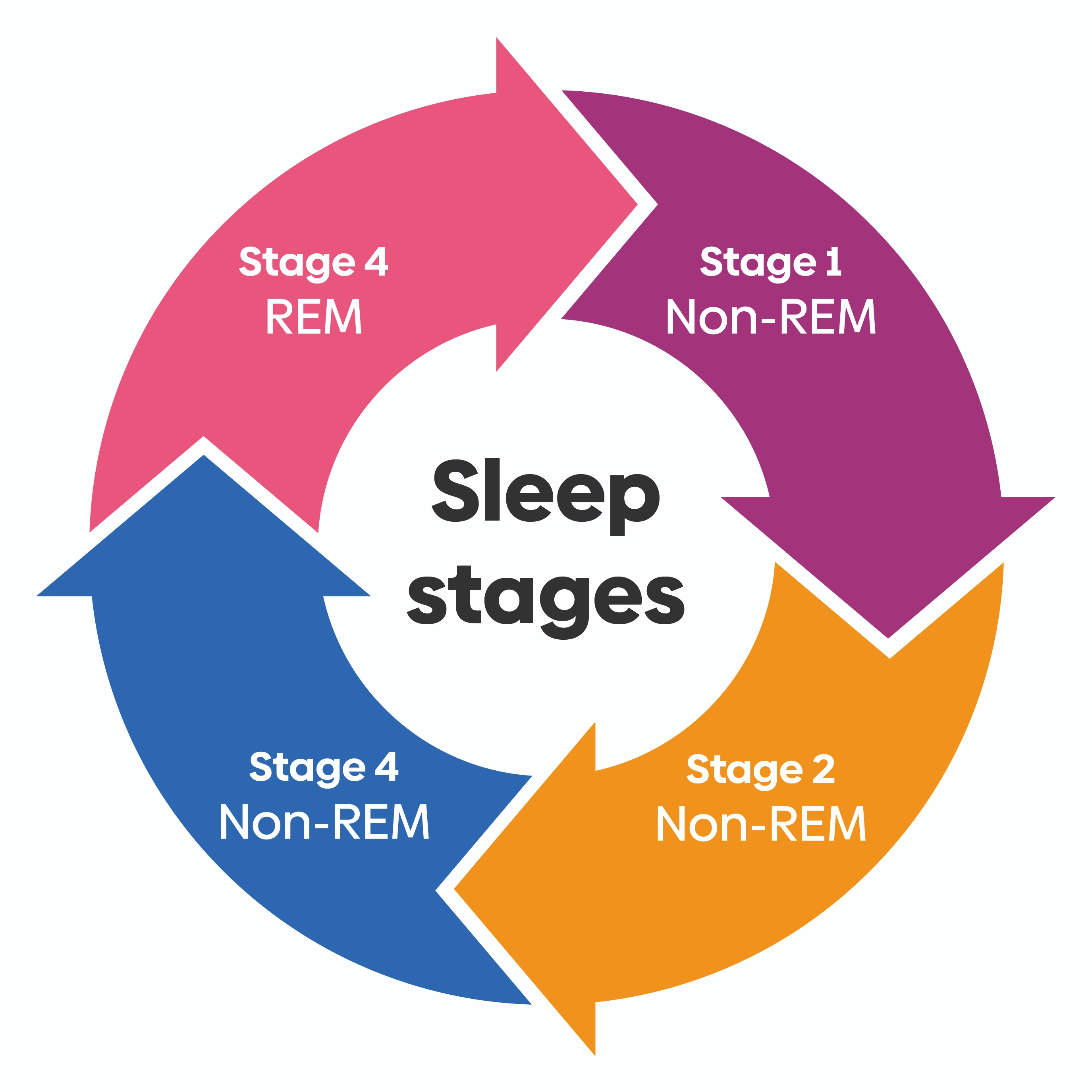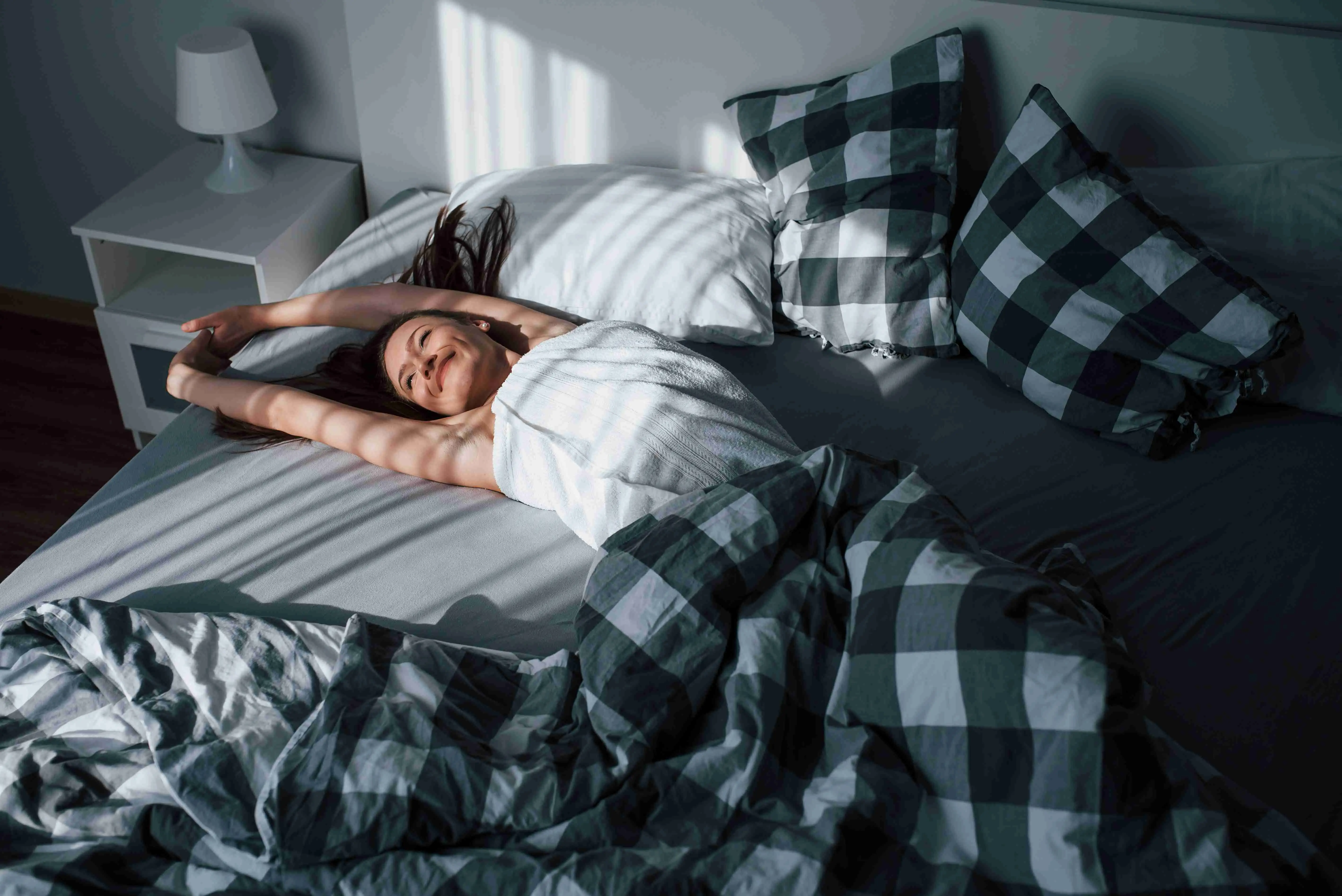Sleep is an essential part of our daily lives, as it allows us to rest and rejuvenate. However, not all sleep is the same. Throughout the night, our bodies go through different sleep stages that are crucial for our overall well-being.
In this article, we will discuss the sleep cycle that our bodies go through, the unique properties of each stage, and its effect on our day-to-day lives.
Understanding the Sleep Cycle

Understanding the sleep cycle is crucial for maintaining a healthy and balanced lifestyle. The sleep cycle consists of different stages, including light sleep, deep sleep, and REM sleep. Each stage has its unique characteristics and plays a vital role in restoring and rejuvenating the body and mind.
During light sleep, the body relaxes and prepares for deeper stages of sleep. Deep sleep is essential for physical restoration, as it promotes muscle growth and repair. REM sleep, on the other hand, is associated with dreaming and cognitive restoration.
By understanding the different stages of the sleep cycle, individuals can optimize their sleep patterns to ensure they wake up feeling refreshed and energized.
Non-Rapid Eye Movement (NREM) Sleep Stages
Non-rapid eye movement (NREM) sleep stages are an essential part of the sleep cycle, characterized by slow brain waves and little to no eye movement.
We divide these stages into three distinct phases: N1, N2, and N3. N1 is the transition stage between wakefulness and sleep, where individuals may experience light sleep and occasional muscle contractions.
Stage 1 (N1)
N1 is the lightest stage of NREM sleep. During this stage, a person is in a transition between wakefulness and sleep. People often report that they were unaware they were asleep during this stage, making it easy to wake them up.
- Duration: The duration of stage 1 NREM sleep can vary from person to person, but it usually lasts for about 5 to 10 minutes. It is the shortest stage of NREM sleep and typically occurs at the beginning of the sleep cycle. As the sleep cycle progresses, the duration of stage 1 decreases, and the person enters deeper stages of NREM sleep.
Stage 2 (N2)
N2 is characterized by specific brain wave patterns and physiological changes.
During this stage, the body transitions from light sleep to a deeper sleep state. The brain waves become slower and more synchronized, with occasional bursts of rapid brain activity known as sleep spindles. These sleep spindles are believed to play a role in memory consolidation and learning.
- Duration: The duration of Stage 2 NREM sleep varies throughout the night. It typically makes up about 45–55% of total sleep time in adults. The first cycle of Stage 2 sleep usually lasts for 10-25 minutes, but subsequent cycles can last longer, up to 20-60 minutes.
Stage 3 (N3)
N3 is the deepest stage of sleep. During this stage, the brain waves become slower and more synchronized, and it becomes difficult to awaken the sleeper.
N3 is characterized by the presence of slow wave sleep (SWS), which is essential for restoring and rejuvenating the body. During this stage, the body releases growth hormones, fostering tissue repair and growth.
- Duration: The duration of N3 sleep varies throughout the night, with longer periods occurring in the first half of the night and shorter periods in the later half. On average, N3 sleep occupies about 20–25% of a healthy adult's total sleep time.
Rapid Eye Movement (REM) Sleep
Rapid Eye Movement (REM) sleep is a distinct phase of the sleep cycle characterized by rapid eye movements, hence the name. It is one of the four stages of sleep that individuals go through during a typical night's rest.
REM sleep typically occurs around 90 minutes after falling asleep and recurs multiple times throughout the night, with each subsequent REM period becoming progressively longer.
- Duration: The duration of REM sleep varies across individuals and age groups. In newborns, REM sleep can account for up to 50% of their total sleep time, gradually decreasing to about 20–25% in adults. The first REM period typically lasts only a few minutes, but it can extend up to an hour in subsequent cycles. As the night progresses, the duration of each REM period generally increases.
Characteristics of REM sleep
During REM sleep, the brain becomes highly active, almost as active as when we are awake. This is the stage where most dreaming occurs, and it is believed to play a crucial role in memory consolidation and emotional processing.
Physiologically, REM sleep is associated with increased heart rate, irregular breathing patterns, and temporary paralysis of voluntary muscles.
Lifestyle Factors

Various factors such as age, lifestyle, and medical conditions can influence sleep patterns and stages, potentially causing variations in sleep stages among individuals.
Age
- Children: Children undergo various sleep stages that are essential for their growth and development. Rapid Eye Movement (REM) sleep, which is associated with dreaming and memory consolidation, occupies a larger portion of children's sleep compared to adults. This is crucial for their cognitive development and learning processes. Additionally, children may experience longer durations of deep sleep, also known as slow-wave sleep. These deep sleep stages are crucial for physical growth, as they facilitate the release of growth hormones in the body. Learn more about Children and Sleep.
- Adults: As people age, they spend less time in REM sleep. Adults spend less time in deep sleep stages, and the overall duration of their sleep tends to decrease as well. Various factors such as increased responsibilities, stress, and hormonal changes can cause this. However, adults still require adequate amounts of both REM and non-REM sleep to maintain optimal cognitive function and overall well-being. Learn more about Adults and Sleep.
- Elders: Older adults typically experience more fragmented sleep with frequent awakenings throughout the night. They may also have difficulty falling asleep or staying asleep for long periods. Age-related factors like changes in hormone production, medical conditions, or medications can cause these changes. Learn more about Adults and Insomnia.
Circadian Rhythm and Sleep Pattern
The circadian rhythm is the internal biological clock that regulates sleep-wake cycles and other physiological processes. External factors like light, temperature, and social cues influence it. Disruptions to the circadian rhythm can cause difficulties in falling or staying asleep.
Additionally, irregular sleep patterns, such as shift work or jet lag, can also affect the sleep stages. These disruptions can result in fragmented or poor-quality sleep, impacting the different stages of sleep, including deep sleep and REM sleep.
Lifestyle Factors
- Physical Activity: Engaging in regular exercise not only helps to improve overall health and well-being but also promotes better sleep. Individuals who engage in moderate to vigorous physical activity on a regular basis tend to experience deeper and more restorative sleep. Learn more about Sleep and Exercise.
- Diet: Consuming a diet high in processed foods, sugar, and caffeine can disrupt sleep patterns. These substances can stimulate the body and make it difficult to fall asleep or stay asleep during the night. On the other hand, a balanced diet rich in fruits, vegetables, whole grains, and lean proteins promotes better sleep by providing essential nutrients and regulating hormone levels. Learn more about Nutrition.
- Screen Time: The use of electronic devices such as smartphones, tablets, and computers before bedtime can hinder the ability to fall asleep quickly and reduce the overall quality of sleep. These devices emit blue light, which suppresses the production of melatonin, a hormone that regulates sleep-wake cycles. Learn more about Electronics and Sleep.
Medical Conditions and Sleep Disorders
- Respiratory Disorders: Respiratory conditions such as asthma, chronic obstructive pulmonary disease (COPD), and sleep apnea can significantly impact the quality of sleep and sleep stages. Sleep apnea, for example, is a common sleep disorder characterized by pauses in breathing during sleep. These pauses can lead to fragmented and restless sleep, resulting in excessive daytime sleepiness and fatigue.
- Neurological Disorders: Examples of neurological conditions that may affect sleep stages include epilepsy, Parkinson's disease, and Alzheimer's disease. Epilepsy can disrupt sleep patterns, leading to excessive daytime sleepiness and impaired cognitive function. Parkinson's disease is associated with sleep disturbances such as insomnia, restless legs syndrome, and rapid eye movement (REM) sleep behavior disorder.
- Sleep Disorders: Medical conditions such as sleep apnea, restless leg syndrome, and insomnia can all contribute to the development of sleep disorders, which in turn affect sleep stages. Insomnia, for example, is characterized by difficulty initiating or maintaining sleep, often caused by underlying medical conditions. Healthcare professionals must identify and address these medical conditions to effectively manage sleep disorders and improve overall sleep quality for their patients.
Psychological and Emotional Factors
- Stress: Stress is a common psychological factor that can have a significant impact on our sleep stages. Our bodies release stress hormones when we experience stress, which can disrupt our natural sleep patterns. This can result in difficulties falling asleep, staying asleep, or experiencing fragmented sleep throughout the night.
- Anxiety: People with anxiety often experience racing thoughts, excessive worry, and restlessness, which can make it challenging to fall asleep or stay asleep throughout the night. Anxiety can also manifest in physical symptoms such as increased heart rate and shallow breathing, further disrupting sleep.
- Depression: Depression is a psychological condition that can have a profound impact on sleep stages. Many people with depression experience insomnia or hypersomnia (excessive sleepiness), which can disrupt the normal sleep-wake cycle. Depressed individuals may struggle to fall asleep, wake up frequently during the night, or feel excessively tired during the day.
- Grief or Trauma: When individuals experience the loss of a loved one, they may struggle with feelings of sadness, anger, confusion, and loneliness. These intense emotions can make it challenging to relax and fall asleep at night. Grieving individuals may also experience vivid dreams or nightmares related to their loss, which can disrupt their sleep stages.
Hormonal Fluctuations
Throughout the night, our body goes through different sleep stages, including light sleep, deep sleep, and REM sleep. Various hormones in our body regulate these stages.
For example, melatonin, also known as the sleep hormone, helps to regulate our sleep-wake cycle. Hormonal imbalances or fluctuations can disrupt the production of melatonin, leading to difficulties falling asleep or staying asleep.
Other hormones, such as cortisol, which is associated with stress, can also impact sleep stages by causing restlessness and reducing the depth of sleep.
Substance Use and Medications
- Caffeine: Consuming caffeine close to bedtime can disrupt the natural sleep cycle, leading to difficulties in achieving deep, restorative sleep. Therefore, it is advisable to limit caffeine intake, especially in the evening, to ensure a good night's sleep.
- Alcohol: While alcohol is initially sedating and may help individuals fall asleep faster, it can negatively affect the overall quality of sleep. Alcohol can disrupt the REM (rapid eye movement) stage of sleep, which is crucial for memory consolidation and emotional regulation.
- Medications: Some medications, such as certain antidepressants and stimulants, may interfere with the natural sleep cycle and lead to sleep disturbances. On the other hand, certain medications like sedatives or sleep aids can induce drowsiness and promote sleep.
Improving Sleep Quality
Improving sleep quality requires the implementation of good sleep hygiene practices. By prioritizing these practices and making them part of daily routines, individuals can enhance their overall sleep experience and wake up feeling refreshed and revitalized.
Sleep Hygiene Practices
- Consistent Sleep Schedule: Consistent sleep involves going to bed and waking up at the same time every day, even on weekends. This helps regulate the body's internal clock and promotes better sleep.
- Relaxing Bedtime Routine: Having a bedtime routine can signal to the body that it is time to wind down and prepare for sleep. This routine can include activities such as reading a book, taking a warm bath, or practicing relaxation techniques like deep breathing or meditation.
- Conducive Sleep Environment: This can be achieved by keeping the room cool, dark, and quiet. Using blackout curtains or an eye mask can help block out any unwanted light, while earplugs or a white noise machine can drown out any disturbing noises.
- Managing Stress: Stress can often interfere with falling asleep or staying asleep throughout the night. Therefore, it is important to find effective ways to manage stress during the day to promote better sleep at night. This can involve engaging in stress-reducing activities such as exercise, yoga, or mindfulness practices.
Lifestyle Modifications
- Limit Stimulant Intake: Stimulants like caffeine and nicotine can interfere with our ability to fall asleep and stay asleep throughout the night. Avoid consuming these substances at least four to six hours before going to bed.
- Limit Screen Time Before Bed: The blue light emitted by electronic devices such as smartphones, tablets, and computers can disrupt our natural sleep-wake cycle. We advise limiting screen time in the evening, preferably at least one hour before bedtime, to improve sleep quality.
- Follow a Healthy Diet: Consuming a balanced diet that includes whole grains, lean proteins, fruits, and vegetables provides essential nutrients that support a good night's sleep. Certain foods, such as almonds, walnuts, kiwi, and warm milk, promote better sleep due to their high content of sleep-promoting compounds like melatonin and magnesium.
- Exercise Regular: Engaging in physical activity on a consistent basis improves both the duration and quality of sleep. Exercise helps regulate our body's internal clock, known as the circadian rhythm, which plays a crucial role in promoting healthy sleep patterns.
Mindfulness and Relaxation Techniques
- Breathing Techniques: Deep breathing exercises can help calm the mind and relax the body, making it easier to fall asleep and stay asleep throughout the night. By focusing on the breath and taking slow, deep breaths, individuals can promote relaxation and reduce feelings of stress and anxiety that often interfere with sleep.
- Yoga: The combination of gentle movements, stretching, and deep breathing incorporated in yoga practices can help release tension from the body and calm the mind. By engaging in regular yoga practice, individuals can reduce stress levels, increase flexibility, and promote better sleep patterns.
- Guided Imagery: Guided imagery involves using visualization techniques to create a peaceful and serene mental image that promotes relaxation. By imagining oneself in a tranquil environment, such as a peaceful beach or a lush forest, individuals can shift their focus away from racing thoughts and worries, allowing the mind to become more relaxed and receptive to sleep.
When to Seek Professional Help

It is important to recognize that sleep stage disturbances can have a significant impact on an individual's physical and mental health.
Chronic sleep deprivation can increase the risk of developing various health conditions, including cardiovascular diseases, obesity, and mood disorders. Seeking professional help early on can help prevent these potential complications and improve overall well-being.
Recognizing Signs of Disrupted Sleep Stages
- Difficulty Falling Asleep: If an individual consistently struggles to fall asleep or stay asleep for a prolonged period of time, it may be indicative of an underlying sleep disorder that requires professional intervention.
- Mood Swings: Sleep stage disturbances can often lead to irritability, mood swings, and difficulties with concentration and memory. If these symptoms persist and begin to affect an individual's interpersonal relationships, work performance, or overall cognitive abilities, it is crucial to seek professional help.
- Decreased Cognitive Functions: If an individual notices a decline in their ability to concentrate, make decisions, or remember information, it may be a result of disrupted sleep stages. This can be caused by various factors, such as sleep apnea, insomnia, or restless leg syndrome. Seeking professional help from a sleep specialist can lead to a proper diagnosis and treatment plan to alleviate these disturbances and improve cognitive functioning.
Symptoms That Indicate Potential Sleep Disorders
- Daytime Fatigue: Daytime fatigue is characterized by feeling excessively tired and lacking energy throughout the day. People with sleep disorders often struggle to fall asleep or stay asleep at night, leading to inadequate rest and daytime drowsiness. This can interfere with daily activities, work productivity, and overall quality of life.
- Headaches: Headaches can be caused by various factors, but individuals with sleep disorders often experience headaches as a result of poor sleep quality or insufficient sleep duration. Sleep deprivation or disrupted sleep patterns can lead to increased tension in the head and neck muscles, triggering headaches.
- Muscle Aches: When we sleep, our muscles relax and recover from the day's activities. However, individuals with sleep disorders may experience muscle discomfort or pain due to restless legs syndrome, periodic limb movement disorder, or other conditions that disrupt normal sleep patterns.
Diagnostic Tools
- Polysomnography: Polysomnography, which is considered the gold standard for diagnosing sleep disorders, involves monitoring various physiological parameters during sleep, including brain activity, eye movements, muscle activity, heart rate, and breathing patterns.
- Actigraphy: Actigraphy involves wearing a small device on the wrist that measures movement and activity levels over an extended period, typically for several days or weeks. This tool provides objective data on sleep patterns and can help identify disruptions in the sleep-wake cycle.
- Sleep Questionnaires: Individuals typically self-administer these questionnaires, which inquire about their sleep habits, daytime sleepiness, and any other symptoms they may be experiencing. Sleep questionnaires provide subjective information about an individual's sleep patterns and can help identify specific sleep disorders.
Learn more about Sleep Studies.
Treatment and Follow-Up
After diagnosis, we can develop an appropriate treatment plan that may involve lifestyle modifications, behavioral therapies, or medication. In some cases, a combination of these approaches may be necessary to effectively address the underlying causes of the sleep disorder.
Additionally, regular follow-up appointments are crucial to monitor the effectiveness of the treatment and make any necessary adjustments.
FAQs
How can you make your sleep cycle healthier?
Establish a consistent sleep schedule by going to bed and waking up at the same time every day; create a relaxing bedtime routine that signals to your body that it's time to sleep; and create a sleep-friendly environment by keeping your bedroom dark, cool, and quiet.
Are all sleep cycles the same?
Sleep cycles are not all the same. The human sleep cycle consists of different stages, including non-REM (rapid eye movement) and REM sleep. These stages vary in duration and depth throughout the night.
What are the symptoms of a lack of REM sleep?
Some common symptoms of a lack of REM sleep include increased daytime sleepiness, difficulty concentrating or focusing, mood disturbances such as irritability or depression, and impaired cognitive function.
How Much Deep Sleep Do You Need?
Generally, adults require around 1-2 hours of deep sleep per night, which accounts for about 20–25% of the total sleep time. However, the need for deep sleep decreases as we age.
Conclusion
Understanding the different sleep stages is vital for maintaining a healthy sleep routine. By recognizing the importance of each stage and taking steps to ensure a consistent and uninterrupted sleep cycle, we can improve our overall well-being and quality of life.
So, the next time you go to bed, remember to embrace all the sleep stages and give your body the rest it deserves.
Dom Abraham
As the lead content writer at Sleepiverse. Dom pours his heart into writing mattress reviews, bedding product reviews, and medically-reviewed health articles. Dom is from Portugal and likes to spend his free time writing on the beach as it gives him a sense of comfort. Aside from writing mattress reviews in front of the soothing beach view, Dom likes to experiment with new amazing food ideas.


